Eurocom Monster 1.0: Clevo's Little Monster
by Vivek Gowri on May 18, 2012 4:55 AM EST- Posted in
- Laptops
- Clevo
- Eurocom
- Ivy Bridge
- Kepler
Gaming On the Go? Not Quite
This is where you end up paying for the upgrade to the quad-core CPU when compared to the M11x. The Monster comes with a 62Wh battery, and ends up delivering battery life slightly better than the Alienware M14x but well short of the M11x. The ULV Sandy Bridge chips were phenomenal under idle conditions, so the M11x R3 had awesome idle battery life, but in our real world use case scenarios, the M11x R3 had battery life about 20% better than the Monster. The two previous generations of M11x were similarly more power efficient than the Monster, but it’s a sacrifice worth making for the vastly more powerful CPU.
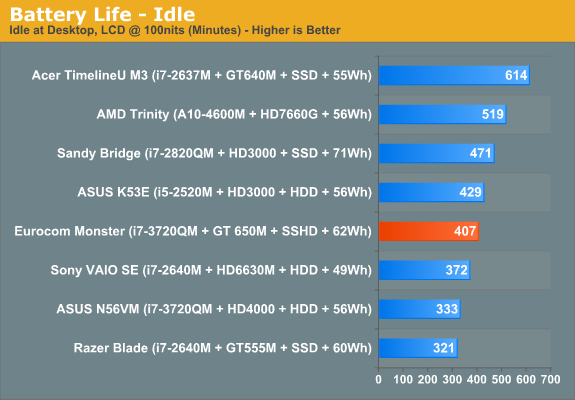
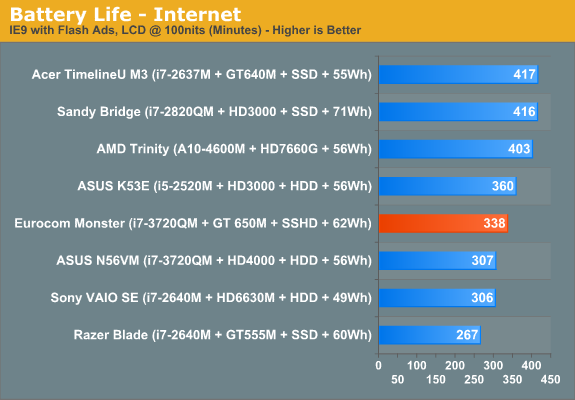
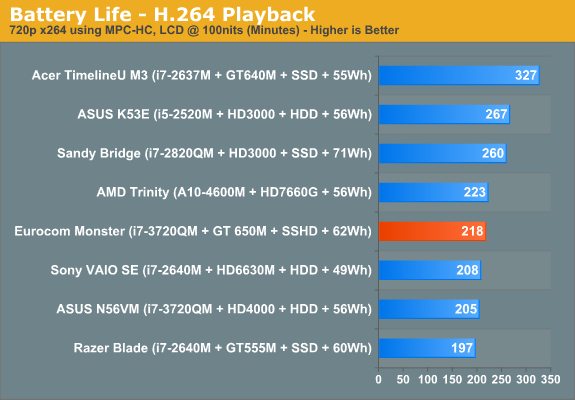

Clevo and Eurocom claim 410 minutes of runtime, and the Monster gets very close to that in our idle battery test, which is the absolute maximum you can expect from the system in an ideal case. Our internet battery test is a much more relevant real world use case scenario, and gives a more realistic estimate of day-to-day battery life, and it slots in at just above 5.5 hours of usable life. I’ve used the Monster as my primary portable for the last ten days or so (including a trip to China) and it’s definitely acquitted itself better than I could have expected.
In terms of gaming battery life (looping 3DMark06), I saw 75 minutes of battery runtime, which is actually pretty decent because we were running the GT 650 in the "prefer maximum performance" setting. For comparison, the ASUS N56VM that served as our IVB test platform ran out of juice at 77 minutes using the HD 4000. But generally, if you're gaming, expect runtime to suffer accordingly.
From a heat standpoint, the numbers aren’t necessarily happy. At idle, temperatures hover in the 60 C range, but load the CPU and GPU and the temperatures climb to the low 90s. I started Furmark and wPrime 1024M (in a loop) and kept it going for a while. After about 10 minutes, temperatures leveled out around 90C for the CPU and motherboard, and 83C for the GPU. That’s….a lot, even higher than the Razer Blade that we tested previously. Do anything more strenuous than surfing and it gets simply too hot to have on your lap. And even under near idle situations like browsing or word processing, the system gets pretty warm to the touch and the fan noticeably kicks in at regular intervals, though unfortunately I don’t have an infrared thermometer to measure the case temps, nor a setup for testing fan noise.
What is very clear though is that the hardware packed into this system is definitely pushing the thermal envelope of the design. There just isn’t enough space to properly ventilate and cool the system via conventional methods. The mechanical engineer in me can think of a few ways that could probably aid in the heat transfer mechanism, but they’re unconventional at best. Quite simply, there needs to either be more surface area to dissipate heat or more airflow to allow for a greater amount of convective heat transfer. Assuming they’re close to constrained for the footprint (which they are, or at least close to it—there’s not too much room to fiddle with the x and y dimensions unless they change the screen size), they just really need to push air through the case. It’s not enough to have a fan for the CPU and GPU, there need to be legitimate case fans, along with a lot more venting. One vent on the left side and a handful of smaller vents on the bottom are clearly not cutting it. Taking certain cooling concepts from desktop cases wouldn’t be a bad idea.


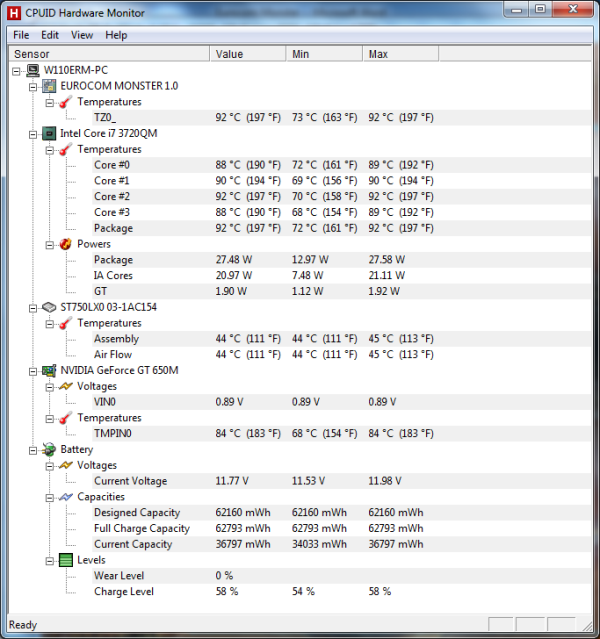
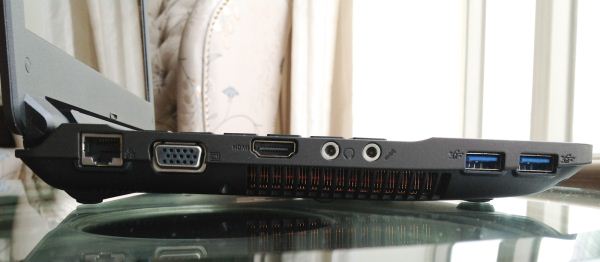








47 Comments
View All Comments
fic2 - Friday, May 18, 2012 - link
Cue the lawsuit from Monster Cable in 3, 2, 1...hsew - Friday, May 18, 2012 - link
This needs an mSata port and a higher resolution display option and it would be worth buying. Thunderbolt would be nice but not critically necessary. Guess that's why they called it the 1.0.Beenthere - Friday, May 18, 2012 - link
...and a 45w CPU for a 11.6" laptop sure don't make good sense.RoninX - Friday, May 18, 2012 - link
It would be interesting to see a comparison, in terms of design and hardware options, of all the different OEM varieties of this Clevo (Eurocom, Origin, Maingear, etc.). Of course, the performance will be similar, if not identical, but the look and feel, and the choices in terms of screens and SSDs, may be different...Also, is there any way to get a 9-cell battery for this?
slim142 - Friday, May 18, 2012 - link
This laptop in 14" with Matte screen, 1680x1050 (or, if too much, then 1440x900) resolution. I would jump on it immediately.maniac5999 - Friday, May 18, 2012 - link
Actually, I have a 12" laptop (MSi Wind 230) and I think that 768p is the right resolution for this size.yhselp - Saturday, May 19, 2012 - link
It really boggles my mind when competent people, even professionals, make subjective claims about products. Did they get caught up in marketing to such an extent that they're no longer able to see a product for what it really is? When was the m11x anything but a shameless, uninnovative shirking of an already dated chassis? A thick notebook which weighs as much as a regular 13.3-incher, yet has a tiny screen and unimpressive components. I'm not saying it's a bad product per se, just an unimaginative one that doesn't push the envelope in any way. Not to mention a glossy screen on an 'ultraportable' machine, although that's a problem with so many products nowadays.What I'm trying to say here, as someone who knows a little about thermal design, is that very few notebooks on the market make optimal use of TDP, and as a result the public has an unrealistic opinion of what's possible. Many people would be surprised by what components you can actually stuff in a given chassis. I don't feel competent enough to say why that is, but I suspect it has something to do with companies being reluctant to develop (and well) new designs as often as they should - even Apple.
W110ER is not a thermal miracle, it doesn't break the laws of physics - it just makes adequate use of thermal limits. However, it's fair to say that the inclusion of 45W CPUs is quite bold (not in a bad way). As for the product itself - it's pretty good (apart from the generic outer design), although I feel that it lacks focus. I'd much rather have either a truly portable 11.6-incher that weighs under 3 lbs and packs a ULV + 640m, or a more practical (and still portable) 13.3-incher at 4.5 lbs with a 35W quad-core + 660m.
I really like it how you guys at AnandTech constantly preach about better displays. In your Vaio SE review you said that its IPS panel should be the bare minimum nowadays - I agree. And to that I'd also add proper thermal optimization. Perhaps Haswell will bring that.
I hope I haven't been offensive, that was not my intent.
VivekGowri - Sunday, May 20, 2012 - link
Set a 4.5lb weight limit, and how many decent gaming systems have there been over the last 3 years? The M11x, the VAIO SA, the first two generations of VAIO Z series (not the new Power Media Dock one), and how many others? The M11x was really the only one of those to be focused on gaming, and the GT 335M was pretty sweet at the $799 price point (in 2010). I wasn't really a huge fan of the M11x (in any of its 3 iterations, actually) primarily due to the size/weight vs screen size, but it was relatively unique in pushing the concept of portable gaming, and that's all the opening paragraph was trying to say.ijozic - Monday, May 21, 2012 - link
Well, there is the 13,3" LG P330 which has a much better design and materials (IMHO), though it's dual core + 555M (somewhat slower than the 650M). Unfortunately, it has a glossy screen, no backlighted keyboard and it's only available in Korea. Hopefully, they'll make an IB refresh and release it worldwide.yhselp - Tuesday, May 22, 2012 - link
Yes, the LG P-series are (and have been) generally well optimized portables. Unfortunately, they've also never been widely available in the US or anywhere outside Korea for that matter. I wonder whether anyone remembers the excellent LG P300 - it used to be a direct competitor to the famous Dell M1330. Unlike the Dell, however, it had a 8600M GS (compared to the slower 8400 GS), better battery life and a somewhat sturdier design. It was quite the machine back then.